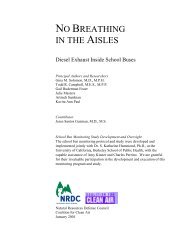US Nuclear Weapons in Europe - Natural Resources Defense Council
US Nuclear Weapons in Europe - Natural Resources Defense Council
US Nuclear Weapons in Europe - Natural Resources Defense Council
You also want an ePaper? Increase the reach of your titles
YUMPU automatically turns print PDFs into web optimized ePapers that Google loves.
U.S. <strong>Nuclear</strong> <strong>Weapons</strong> <strong>in</strong> <strong>Europe</strong> • Hans M. Kristensen/<strong>Natural</strong> <strong>Resources</strong> <strong>Defense</strong> <strong>Council</strong>, 2005<br />
Figure 16:<br />
F-15E Refuel<strong>in</strong>g Over Iraq<br />
An F-15E Strike Eagle from the 336 th Fighter Squadron of the 4 th<br />
Fighter W<strong>in</strong>g refuels from a KC-135 dur<strong>in</strong>g Operation Northern<br />
Watch over Iraq <strong>in</strong> 1999. Based at Seymour Johnson Air Force Base<br />
<strong>in</strong> North Carol<strong>in</strong>a, the 4 th Fighter W<strong>in</strong>g is tasked with provid<strong>in</strong>g<br />
nuclear strike support to <strong>Europe</strong>an Command.<br />
Source: U.S. Air Force.<br />
Part of the justification for this was the large number of Russian tactical nuclear weapons.<br />
The NATO <strong>Nuclear</strong> Plann<strong>in</strong>g Group (NPG) <strong>in</strong> June 1997 h<strong>in</strong>ted at this <strong>in</strong> the f<strong>in</strong>al<br />
communiqué, but the language was vague. 148 Much more direct was an <strong>in</strong>ternal message<br />
sent by the U.S. Commander <strong>in</strong> Chief, <strong>Europe</strong>an Forces (<strong>US</strong>CINCEUR) <strong>in</strong> December<br />
1997 <strong>in</strong> response to ACC’s suggestion to change the read<strong>in</strong>ess level of DCAs. The<br />
elements of the threat were, accord<strong>in</strong>g to <strong>US</strong>CINCEUR:<br />
• “The strategic threat to NATO territory has been significantly reduced, but<br />
Russian tactical nuclear weapons and the doctr<strong>in</strong>e to employ them rema<strong>in</strong> a threat<br />
to NATO. Russia ma<strong>in</strong>ta<strong>in</strong>s at least a 3 to 1 advantage <strong>in</strong> tactical nuclear<br />
weapons as compared to the U.S. and a vastly greater advantage over NATO.<br />
The Russians enjoy a near 40 to 1 advantage <strong>in</strong> delivery systems. Significantly,<br />
Russian tactics have evolved to lean more heavily than before on tactical nuclear<br />
weapons as their conventional force effectiveness has decl<strong>in</strong>ed.<br />
• Additionally, the proliferation of weapons of mass destruction by states with<strong>in</strong> the<br />
EUCOM AOR/AOI and their ability to target the capitals of <strong>Europe</strong> is of grow<strong>in</strong>g<br />
concern.” 149<br />
This rationale had one leg <strong>in</strong> the past (Russian nuclear forces) and another <strong>in</strong> the future<br />
(proliferation). <strong>US</strong>CINCEUR drew a l<strong>in</strong>e <strong>in</strong> the sand to any further considerations of<br />
chang<strong>in</strong>g the posture and said that the read<strong>in</strong>ess levels for DCAs <strong>in</strong> the United States<br />
49
















